Clan Stewart
| Figure | Name of armiger and blazon |
 | Stewart (Clan Stewart) Or, a fess chequy argent and azure of three rows. |
The House of Stuart is a noble family of Scottish origin that eventually became monarchs of Scotland, England, Ireland, and Great Britain.
| Figure | Name of armiger and blazon |
 | Stewart (Clan Stewart) Or, a fess chequy argent and azure of three rows. |
| Figure | Name of armiger and blazon |
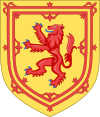 | Robert II of Scotland (1316 – 19 April 1390), King of Scotland, Or, a lion gules within a double tressure flory counter-flory of the same, armed and langued azure (Scotland). |
 | David Stuart (born 1356), Earl of Strathearn and Earl of Caithness, son of preceding, Or, a lion gules within a double tressure flory counter-flory of the same, armed and langued azure (Scotland), a chevron gules, brochant, a fess chequy argent and azure brochant sur-le-tout (Stuart). [1] [ better source needed ] |
 | John Stuart (v. 1337 – 4 April 1406), Earl of Carrick, future Robert III of Scotland, Or, a lion gules within a double tressure flory counter-flory of the same, armed and langued azure (Scotland), a label argent, each point chequy azure and argent. [1] |
 | Alexander Stuart (30 April 1514, Stirling Castle – 18 December 1515, Stirling Castle), Duke of Ross, son of James IV of Scotland, Or, a lion gules within a double tressure flory counter-flory of the same, armed and langued azure (Scotland), a fess chequy argent and azure (Stuart), brochant sur-le-tout. [1] |
Branch issued from the marriage of Marie Stuart and Henry Stuart, Lord Darnley, (7 December 1545 – 9 or 10 February 1567), Baron Darnley, Duke of Albany and King consort of Scotland,
| Figure | Name of armiger and blazon |
 then then  | James VI Stuart or James I of England (1566–1625), Kings of Scotland, then King of England, Or, a lion gules within a double tressure flory counter-flory of the same, armed and langued azure (Scotland), a label argent. Then, Quarterly, I and IV grandquarterly: 1 and 4 azure three fleurs de lys or (France modern) and 2 and 3 gules three lions passant guardant or (England) ; II or, a lion gules, double tressure flory and counter-flory of the same (Scotland) and III azure, a harp or, stringed argent (Ireland). |
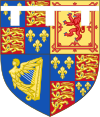 | Charles Stuart (1630–1685), Prince of Wales, Duke of Cornwall and Duke of Rothesay, future Charles II of England, Quarterly, I and IV grandquarterly: 1 and 4 azure three fleurs de lys or and 2 and 3 gules three lions passant guardant or; II or, a lion gules, double tressure flory and counter-flory of the same and III azure, a harp or, stringed argent; overall a label argent. |
 | James Stuart (1633–1701), Duke of York, Duke of Albany, future James II of England, Quarterly, I and IV grandquarterly: 1 and 4 azure three fleurs de lys or and 2 and 3 gules three lions passant guardant or; II or, a lion gules, double tressure flory and counter-flory of the same and III azure, a harp or, stringed argent ; overall a label argent, on each point three ermine spots sable. |
 | Henry Stuart (1640–1660), Duke of Gloucester, Earl of Cambridge Quarterly, I and IV grandquarterly: 1 and 4 azure three fleurs de lys or and 2 and 3 gules three lions passant guardant or; II or, a lion gules, double tressure flory and counter-flory of the same and III azure, a harp or, stringed argent; overall a label argent, on each point three roses gules. |
 | Mary II Stuart , Queen of England and Ireland, Per pale: 1 quarterly, I and IV grandquarterly: 1 and 4 azure three fleurs de lys or and 2 and 3 gules three lions passant guardant or; II or, a lion gules, double tressure flory and counter-flory of the same and III azure, a harp or, stringed argent; sur le tout azure semy of billets or, a lion of the second brochant, armed and langued gules (Nassau); 2 quarterly, I and IV grandquarterly: 1 and 4 azure three fleurs de lys or and 2 and 3 gules three lions passant guardant or; II or, a lion gules, double tressure flory and counter-flory of the same and III azure, a harp or, stringed argent. |
 | Anne Stuart , Queen of Great Britain, Quarterly, I and IV Per pale: 1 gules three lions passant guardant or, 2 or, a lion gules, double tressure flory and counter-flory of the same; II azure three fleurs de lys or; III azure, a harp or, stringed argent. |
Branch descended from James Crofts, illegitimate son of Lucy Walter and of Charles II of England,
| Figure | Name of armiger and blazon |
 | James Crofts then James Scott (1 April 1649, Rotterdam –15 July 1685), 1st duke of Monmouth, 1st duke of Buccleuch, illegitimate son of Charles II of England and of his mistress, Lucy Walter, who had followed the king in exile on the continent after execution of Charles I. Quarterly: I and IV grandquarterly azure three fleurs de lys or France and gules three lions passant guardant or (England); II or, a lion gules, double tressure flory and counter-flory of the same (Scotland) ; III azure, a harp or, stringed argent (Ireland) ; a baton sinister couped argent brochant, sur le tout or a bend azure charged with a mullet of six points and two crescents, one in base, the other in chief of the bend, all of the first (Scott).
|
 | Henry Scott, (2 September 1746 – 11 January 1812), 3rd Duke of Buccleuch and 5th Duke of Queensberry etc., son of preceding and of Caroline Townshend, 1st Baroness Greenwich. Grand-Quarterly:
|
 | Charles William Henry Montagu-Scott (24 May 1772 – 20 April 1819), 4th duke of Buccleuch and 6th duke of Queensberry, etc., son of preceding and of Lady Elizabeth Montagu. Grand-Quarterly:
|
 | Walter Montagu-Douglas-Scott (25 November 1806 – 16 April 1884), 5th duke of Buccleuch and 7th duke of Queensberry, etc., son of preceding and of Harriet Katherine Townshend, daughter of Thomas Townshend, 1st Viscount Sydney, Grand-quarterly:
|
 | Walter Montagu-Douglas-Scott (30 December 1894 – 4 October 1973), 8th duke of Buccleuch and 10th duke of Queensberry, etc., son of preceding and of Margaret Bridgeman, daughter of George Bridgeman, 4th Earl of Bradford, Grand-quarterly:
|
| Figure | Name of armiger and blazon |
 | Charles FitzCharles (1657–1680), 1st Earl of Plymouth, natural son of Charles II of England Quarterly: I and IV grandquarterly azure three fleurs de lys or (France modern) and gules three lions passant guardant or (England); II or, a lion gules, double tressure flory and counter-flory of the same (Scotland); III azure, a harp or, stringed argent (Ireland); a baton sinister vair. |
Branch descended Charles II of England and his mistress Barbara Palmer
| Figure | Name of armiger and blazon |
 | Charles Fitzroy (1662–1730), future duke of Southampton (1675), duke of Cleveland (1709) Quarterly: I and IV grandquarterly azure three fleurs de lys or (France) and gules three lions passant guardant or (England); II or, a lion gules, double tressure flory and counter-flory of the same (Scotland) ; III azure, a harp or, stringed argent (Ireland) ; a baton sinister argent charged of six ermine spots sable. |
 | Henri Charles FitzRoy (1663–1690), 1st Duke of Grafton, 1st earl Euston, 1st Viscount Ipswich, 1st Baron Sudbury, Quarterly: I and IV grandquarterly azure three fleurs de lys or (France) and gules three lions passant guardant or (England); II or, a lion gules, double tressure flory and counter-flory of the same (Scotland) ; III azure, a harp or, stringed argent (Ireland) ; a baton sinister couped azure compony argent of six pieces.
|
 | George Fitzroy (1665–1716), future earl of Northumberland (1674), duke of Northumberland (1683), childless, Quarterly: I and IV grandquarterly azure three fleurs de lys or (France) and gules three lions passant guardant or (England) ; II or, a lion gules, double tressure flory and counter-flory of the same (Scotland) ; III azure, a harp or, stringed argent (Ireland) ; a baton sinister couped azure compony argent of six pieces, each piece argent charged with an ermine spot sable. |
Branch descended from Charles Beauclerk, illegitimate son of Nell Gwynne, mistress of Charles II of England,
| Figure | Name of armiger and blazon |
 | Charles Beauclerk (1670–1726), 1st Duke of St Albans, earl of Burford and Baron of Heddington, Quarterly: I and IV, grandquarterly azure three fleurs de lys or (France modern) and gules three lions passant guardant or (England) ; II, or, a lion gules, double tressure flory and counter-flory of the same (Scotland); III, a harp or, stringed argent (Ireland); a baton sinister couped gules, charged with three roses argent, seeded and barbed vert, brochant sur-le-tout. |
 | Charles Beauclerk (1696–1751), 2nd Duke of St Albans, earl of Burford and Baron of Heddington, Hereditary Grand Falconer of England, son of preceding, Grand-Quarterly: A and D, of Beauclerk: quarterly: I and IV, grandquarterly azure three fleurs de lys or (France modern) and gules three lions passant guardant or (England) ; II, or, a lion gules, double tressure flory and counter-flory of the same (Scotland); III, a harp or, stringed argent (Ireland); a baton sinister couped gules, charged with three roses argent, seeded and barbed vert, brochant sur-le-tout; C and D de Vere: quarterly gules and or, a mullet argent on the first quarterargent.
|
Branch descended from Charles Lennox, natural son of Charles II of England,
| Figure | Name of armiger and blazon |
 | Charles Lennox (1672–1723), 1st duke of Richmond (2nd creation), 1st duke of Lennox, duke of Aubigny. Quarterly: I and IV grandquarterly azure three fleurs de lys or (France modern) and gules three lions passant guardant or (England) ; II or, a lion gules, double tressure flory and counter-flory of the same (Scotland) ; III azure, a harp or, stringed argent (Ireland) ; a bordure compony of sixteen pieces argent and gules, each piece argent charged with a rose seeded or and barbed vert (Lennox).
|
 | Charles Lennox (1764–1819), nephew of preceding, 4th Duke of Richmond, Baron Settingdon and Earl of March, 4th Duke of Lennox, Baron Torbolton and Earl of Darnley, Duke of Aubigny, Quarterly: I and IV grandquarterly azure three fleurs de lys or (France) and gules three lions passant guardant or (England); II or, a lion gules, double tressure flory and counter-flory of the same (Scotland) ; III azure, a harp or, stringed argent (Ireland); a bordure compony of sixteen pieces argent and gules, each piece argent charged with a rose seeded or and barbed vert (Lennox); sur le tout gules three buckles or (Aubigny). |
 | Charles Gordon-Lennox (1791–1860), nephew of preceding, 5th Duke of Richmond, Baron Settingdon and Earl of March, 5th Duke of Lennox, Baron Torbolton and Earl of Darnley, Duke of Aubigny, Grand-quarterly: I and IV grandquarterly azure three fleurs de lys or (France) and gules three lions passant guardant or (England); II or, a lion gules, double tressure flory and counter-flory of the same (Scotland); III azure, a harp or, stringed argent (Ireland); a bordure compony of sixteen pieces argent and gules, each piece argent charged with a rose seeded or and barbed vert (Lennox); sur le tout gules three buckles or (Aubigny); II and III of the grand-quarterly: quarterly I azure three boar's heads or armed gules (Gordon); II or three heads of lion erased gules langued azure (Badenoch); III or, three crescents gules, double tressure flory and counter-flory of the same (Seton); IV azure three cinquefoils or seeded of the field (Fraser).
|
Branch descended from James FitzJames, 1st Duke of Berwick, natural son of James II of England,
| Figure | Name of armiger and blazon |
 | James FitzJames (Moulins, 21 August 1670 – 12 June 1734), natural son of James II Stuart, King of England and of Arabella Churchill, sister of John Churchill, duke of Marlborough, 1st Duke of Berwick, 1st earl of Tinmouth, 1st baron of Bosworth, Duke of Liria and Xerica and Grandee of Spain, Duke of Fitz-James and peer of France, Knight of the Order of the Garter (1688, brevet n°498), Knight of the Golden Fleece (1704, brevet n°636), Knight of the Holy Spirit (received 7 June 1724) Quarterly: I and IV grandquarterly azure three fleurs de lys or (France) and gules three lions passant guardant or (England); II or, a lion gules, double tressure flory and counter-flory of the same (Scotland) ; III azure, a harp or, stringed argent (Ireland); a bordure compony of twelve pieces azure and gules, each piece azure charged with a fleur-de-lys and each piece gules charged with a lion passant guardant or.
|
 | Charles Michel Fitz-James (1794–1835), 14th Duke of Alba (1802) and Grandee of Spain, Duke of Liria and Xerica, Duke of Berwick,
|
Branch descended from Robert Stuart, Duke of Albany, son of Robert II of Scotland.
| Figure | Name of armiger and blazon |
 | Robert (circa 1340 – 3 September 1420 - Stirling), Duke of Albany, Quarterly: I and IV or a lion gules a label azure in chief, II and III or, a fess chequy argent and azure a label azure in chief. |
 | Murdoch Stuart (1362–1425), Duke of Albany, son of preceding, Quarterly: I and IV or, a lion gules, double tressure flory and counter-flory of the same (Scotland) a bordure azure and argent compony of twelve pieces, II or, a fess chequy azure and argent, and III or three lozenges pommety gules double tressure flory and counter-flory of the same. |
 | Alexander Stuart (died before 2 June 1489), Lord Avandale, great-grandson of preceding, Quarterly: I or, a lion gules armed and langued azure, double tressure flory and counter-flory of the same (Scotland), II or, a fess chequy azure and argent, III argent, a saltire gules, between four roses of the same, seeded or and barbed vert (Lennox), IV or a lion gules armed and langued azure, a bordure azure and argent compony of twelve pieces. |
 | Andrew Stuart, 1st Lord Ochiltree, grandson of preceding, Quarterly: I and IV or, a lion gules armed and langued azure, double tressure flory and counter-flory of the same (Scotland), II or, a fess chequy argent and azure a bordure azure and argent compony of twelve pieces a label gules, III argent, a saltire gules, between four roses of the same, seeded or and barbed vert (Lennox), a bordure azure and argent compony of twelve pieces. |
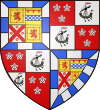 | James Stuart (assassinated 5 December 1595), Earl of Arran, son of preceding, Grand quarterly: A and D, quarterly: I and IV or, a lion gules armed and langued azure, double tressure flory and counter-flory of the same (Scotland), II or, a fess chequy argent and azure a bordure azure and argent compony of twelve pieces a label gules, III argent, a saltire gules, between four roses of the same, seeded or and barbed vert (Lennox), a bordure azure and argent compony of twelve pieces ; B and C, quarterly: I and IV gules three cinquefoils argent, each leaf charged with an ermine spot sable, II and III, argent a lymphad with the sails furled sable flagged gules (Hamilton). |
 | Alexander Stuart (born around 1557), 1st Lord of Ardvorlich, descendant of James Stuart, fourth son of Murdoch Stuart , who had fled to Ireland, Quarterly: I and IV or, a lion gules armed and langued azure, double tressure flory and counter-flory of the same (Scotland), II or, a fess chequy argent and azure in chief a mullet gules, III argent, a saltire gules, between four roses of the same, seeded or and barbed vert (Lennox), a bordure azure and argent engrailed and compony of twelve pieces. |
| Figure | Name of armiger and blazon |
 | John Stuart of Darnley , Seneschal, Or, a fess chequy azure and argent, a baton gules. [2] [ better source needed ] |
 | Alexander Stuart , 1st Earl of Buchan, Or, a fess chequy argent and azure. [1] |
 | John Stuart (circa 1381 – 17 August 1424), Lord Darnley, 1st Lord of Aubigny, Lord of Concressault and Count of Evreux, Quarterly: I and IV azure three fleurs de lys or, a bordure gules with eight buckles or; II and III or, a fess chequy argent and azure of three rows (Stuart) a cottice gules. |
 | Lord Darnley (29 July 1565 – 10 February 1567), King consort of Scots to Queen Mary, Duke of Albany, Lord of Darnley, |
| Figure | Name of armiger and blazon |
 | John Stewart (died 1495), 1st Earl of Lennox (1473 – 2nd creation [lower-alpha 1] ), Baron of Tolborton, grandson of preceding, Quarterly: I and IV azure three fleurs de lys or, a bordure gules with eight buckles or ; II and III or, a fess chequy argent and azure of three rows (Stuart) a bordure engrailed gules ; sur le tout argent, a saltire gules, between four roses of the same, seeded or and barbed vert (Lennox).
|
 | Esmé Stewart (1542–1583), 7th Earl of Lennox (1580), then 1st duke of Lennox (1581–creation), earl of Darnley, Quarterly: I and IV azure three fleurs de lys or, a bordure engrailed or ; II and III or, a fess chequy argent and azure of three rows (Stuart) a bordure gules with eight buckles or ; sur le tout argent, a saltire gules, between four roses of the same, seeded or and barbed vert (Lennox).
|
| Figure | Name of armiger and blazon |
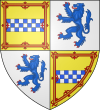 | James Stuart of Bute , (deceased 4 June 1710), 3rd Baronet Stuart of Ardmaleish, 1st earl of Bute (1703), Quarterly: I and IV or, a fess chequy argent and azure of three rows, double tressure flory and counter-flory gules, II and III argent a lion gules armed and langued azure. |
 | John Stuart of Bute (25 May 1713 – 10 March 1792), 3rd Earl of Bute, minister of State and Prime Minister of Great Britain from 1762 to 1763. Or, a fess chequy argent and azure of three rows, within a double tressure flory and counter-flory gules. |
| Figure | Armiger and Blazon |
 | Stewart earl of Galloway, Branch descended from Alexander Stewart (deceased 1649), 1st earl of Galloway, Or, a fess chequy argent and azure of three rows, double tressure flory and counter-flory gules, a bend engrailed of the same. |
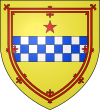 | barons Stewart of Rothesay Or, a fess chequy argent and azure of three rows in chief a mullet argent, double tressure flory and counter-flory gules. |
 | Stewart of Atholl, Quarterly or a fess chequy argent and azure (Stewart) and or three pallets sable (Earl of Atholl). [3] Arms used by: John Stewart (1440 – 15 September 1512, Laighwood), 1st earl of Atholl, |
 | Stewart of Barclye, Or a fess chequy argent and azure, a bend engrailed gules brochant in chief a mullet of the same. [3] |
 | Stewart of Garlies, Or, a fess chequy argent and azure of three rows, a bend engrailed gules brochant. [3] |
 | Stewart of Minto, Or a fess chequy argent and azure, a bend engrailed gules brochant in chief a rose of the same. [3] |
 | Stewart of Physgill, Or a fess chequy argent and azure, a bend engrailed brochant gules charged in chief with a buckle of the field. [3] [ better source needed ] |
 | Lords Blantyre , Branch descended from Walter Stewart (deceased 8 Mars 1617), 1st Lord Blantyre (1606), Argent, a fess chequy argent and azure of three rows in chief a mullet of the second, a bend engrailed gules, in chief a rose of the same seeded and barbed or. |
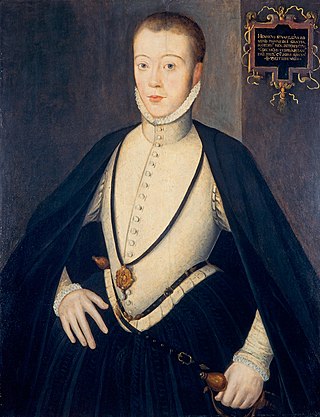
Henry Stuart, Lord Darnley, was an English nobleman who was the second husband of Mary, Queen of Scots, and the father of James VI of Scotland and I of England. Through his parents, he had claims to both the Scottish and English thrones, and from his marriage in 1565 he was king consort of Scotland. Less than a year after the birth of his son, Darnley was murdered at Kirk o' Field in 1567. Many contemporary narratives describing his life and death refer to him as simply Lord Darnley, his title as heir apparent to the Earldom of Lennox.

The House of Stuart, originally spelled Stewart, was a royal house of Scotland, England, Ireland and later Great Britain. The family name comes from the office of High Steward of Scotland, which had been held by the family progenitor Walter fitz Alan. The name Stewart and variations had become established as a family name by the time of his grandson Walter Stewart. The first monarch of the Stewart line was Robert II, whose male-line descendants were kings and queens in Scotland from 1371, and of England, Ireland and Great Britain from 1603, until 1714. Mary, Queen of Scots, was brought up in France where she adopted the French spelling of the name Stuart.
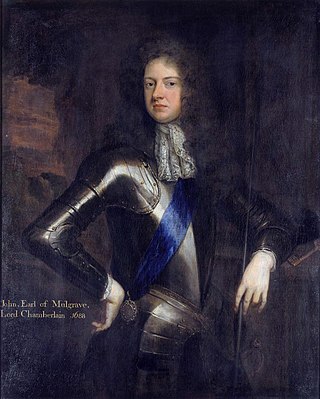
Duke of Buckingham and Normanby is a title in the Peerage of England. The full title was Duke of the County of Buckingham and of Normanby but in practice only Duke of Buckingham and Normanby was used. The dukedom was created in 1703 for John Sheffield, 1st Marquess of Normanby KG, a notable Tory politician of the late Stuart period, who served under Queen Anne as Lord Privy Seal and Lord President of the Council. He had succeeded his father as 3rd Earl of Mulgrave in 1658 and been made Marquess of Normanby in 1694.

Duke of Albany is a peerage title that has occasionally been bestowed on younger sons in the Scottish and later the British royal family, particularly in the Houses of Stuart and Hanover.

Duke of Richmond is a title in the Peerage of England that has been created four times in British history. It has been held by members of the royal Tudor and Stuart families.
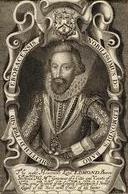
The title Earl of Mulgrave has been created twice. The first time as a title in the Peerage of England and the second time as a Peerage of the United Kingdom.

Charles Lennox, 1st Duke of Richmond, 1st Duke of Lennox,, of Goodwood House near Chichester in Sussex, was the youngest of the seven illegitimate sons of King Charles II, and was that king's only son by his French-born mistress Louise de Kérouaille, Duchess of Portsmouth. He was appointed Hereditary Constable of Inverness Castle.

The Earl or Mormaer of Lennox was the ruler of the region of the Lennox in western Scotland. It was first created in the 12th century for David of Scotland, Earl of Huntingdon and later held by the Stewart dynasty.

The House of Egmond or Egmont is named after the Dutch town of Egmond, province of North Holland, and played an important role in the Netherlands during the Middle Ages and the Early modern period. The main lines Egmond-Geldern, Egmond-Gavere and Egmond-Buren-Leerdam had high noble, princely rank.

Charles Stewart, 3rd Duke of Richmond, 6th Duke of Lennox KG of Cobham Hall in Kent and of Richmond House in Whitehall, London, 11th Seigneur d'Aubigny in France, was an English nobleman of Franco-Scottish ancestry and a 4th cousin of King Charles II of England, both being descended in the male line from John Stewart, 3rd Earl of Lennox.
La Tour d'Auvergne was a noble French dynasty. Its senior branch, extinct in 1501, held two of the last large fiefs acquired by the French crown, the counties of Auvergne and Boulogne, for about half a century. Its cadet branch, extinct in 1802, ruled the duchy of Bouillon in the Southern Netherlands from 1594, and held the dukedoms of Albret and Château-Thierry in the peerage of France since 1660. The name was also borne by Philippe d'Auvergne, an alleged collateral of the original Counts of Auvergne, and was adopted by the famous soldier Théophile Corret de la Tour d'Auvergne, who descended from an illegitimate line of the family.
Stewart of Darnley, also known as the Lennox Stewarts, were a notable Scots family, a branch of the Clan Stewart, who provided the English Stuart monarchs with their male-line Stuart descent, after the reunion of their branch with the royal Scottish branch.

Duke of Aubigny is a title that was created in the Peerage of France in 1684. It was granted by King Louis XIV of France to Louise de Kérouaille, the last mistress of King Charles II of England, and to descend to Charles's illegitimate issue by her, namely to the descendants of Charles Lennox, 1st Duke of Richmond, 1st Duke of Lennox (1672–1723) of Goodwood House in Sussex. Louis XIV also granted her the Château de la Verrerie, a former secondary seat of the Stewart Seigneurs d'Aubigny, Franco-Scottish cousins of the Stewart monarchs, seated from 1422 to 1672 at the Château d'Aubigny in the parish and manor of Aubigny-sur-Nère in the ancient province of Berry in France.

Clan Lennox is a Lowland Scottish clan. The clan chiefs were the original Earls of Lennox, although this title went via an heiress to other noble families in the fifteenth and sixteenth centuries. The chiefship of the clan then went to the Lennox of Woodehead branch.

Clan Stewart is a Scottish Highland and Lowland clan. The clan is recognised by Court of the Lord Lyon; however, it does not have a Clan Chief recognised by the Lord Lyon King of Arms. Because the clan has no chief it can be considered an armigerous clan; however, the Earls of Galloway are now considered to be the principal branch of this clan, and the crest and motto of The Earls of Galloway's arms are used in the Clan Stewart crest badge. The Court of the Lord Lyon recognises two other Stewart/Stuart clans, Clan Stuart of Bute and Clan Stewart of Appin. Clan Stuart of Bute is the only one of the three clans at present which has a recognised chief.

FitzAlan is an English patronymic surname of Anglo-Norman origin, descending from the Breton knight Alan fitz Flaad, who accompanied king Henry I to England on his succession. He was grandson of the Seneschal of the Bishop of Dol. The FitzAlan family shared a common patrilineal ancestry with the House of Stuart.
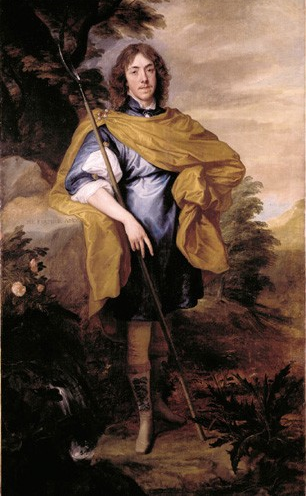
Lord George Stewart, 9th Seigneur d'Aubigny was an Anglo-Scottish nobleman of French descent and a third cousin of King Charles I of England. He supported that king during the Civil War as a Royalist commander and was killed, aged 24, at the Battle of Edgehill in 1642.

Charles I of England was the second King of the then newly enthroned House of Stuart and had many descendants. He was the second but eldest surviving son of King James I of England. He became heir apparent to the English, Irish and Scottish thrones on the death of his elder brother in 1612. Later, he married a Bourbon princess, Henrietta Maria of France, after a failed Spanish match.

The Château de la Verrerie is a château in Oizon, in the ancient province of Berry in France. It is an historic ancestral seat of a junior branch of the Scottish House of Stewart, known by the territorial title Seigneur d'Aubigny. It is situated about 14 miles south-east of Aubigny-sur-Nère, and the Château d'Aubigny, the original seat of its owners.
This article includes a list of general references, but it lacks sufficient corresponding inline citations .(May 2019) |